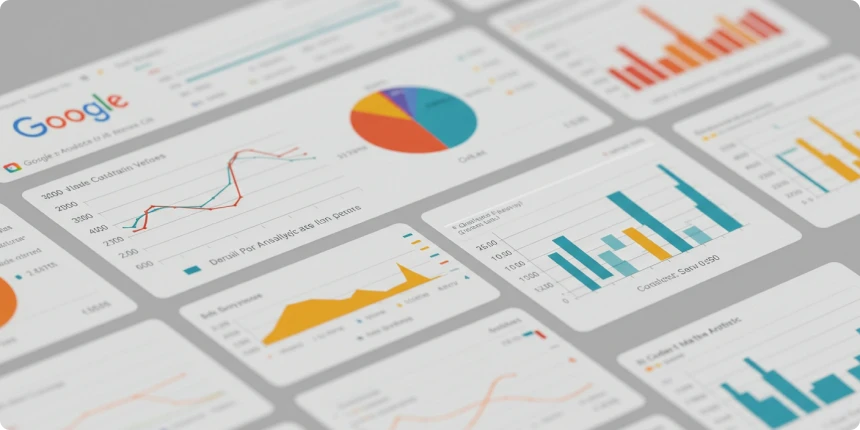
Get Started with Google Analytics 4 (GA4)

- ZARYAB
In the digital age, everything you do is data – and data informs smarter marketing decisions. Knowing how your users behave, where they are coming from, and how they use your website or app can be the difference between growth and inertia. And that’s where Google Analytics 4 (GA4) steps into the picture.
GA4 is Google’s new analytics property that’s built to replace Universal Analytics (UA). With a greater emphasis on user paths and journeying, event-based measurement and privacy compliance, and powered by machine learning insights, GA4 provides businesses with the insights they need to remain competitive in an evolving digital landscape.”
Below, we’ll dissect the ins and outs of GA4, what it is, why you should care, and how to get started today.
What is Google Analytics 4 (GA4)?
Google Analytics 4 (GA4) is the latest version of Google Analytics, which is designed to meet the changing needs of businesses for data analytics in today’s digital-first, privacy-focused world. Instead of following the sessions and pageviews setup of Universal Analytics, you can think of GA4 as events and parameters, which provide marketers with a much more granular look into how users engage with content.
Unlike the traditional focus on “how many people visited,” GA4 tells you what people did, when, and how they navigated the different platforms (such as apps and websites) in which your digital properties exist.
Why Businesses Should Care About GA4?
- Privacy-First by Design: In GDPR’s wake and with changing data privacy laws, GA4 is engineered to capture data responsibly and not to be as heavy a user of third-party cookies.
- Cross-platform tracking: Track and follow your users on websites and apps so as to be better informed about your customers’ journey.
- Predictive Insights: GA4 leverages machine learning to predict actions such as likelihood to churn and likely revenue.
- Better Reporting: No more dry reports, GA4 makes it adaptable to report based on business goals rather than dozens of fixed reports.
Key Features of Google Analytics 4
- Event-Based Data Model: When one interacts, clicks, scrolls, watches a video, or purchases, it is all tracked as an event.
- Improved Measurement: GA4 automatically measures key interactions such as file downloads, video views, and outbound clicks.
- AI-Powered Predictions: Learn what your customers might do–without setup.
- Customer-Based Model: View user paths across both devices and platforms.
- Custom Audiences for Ads: Build a segmented audience for Google Ads from your GA4 reports.
How to Set Up GA4 (Step-by-Step)
- Create a GA4 Property: In Google Analytics, navigate to Admin > Create Property and choose GA4.
- Implement GA4 Tag: Implement the GA4 tracking tag through Google Tag Manager or directly on your site.
- Set Up Data Streams: Decide if you’d like to track a website, app, or both. Both will serve as data feeds for GA4.
- Set up Events & Conversions: Determine what actions are most important for your business (e, purchases, sign-ups, form submissions) and identify them as conversions.
- Link to Google Ads: Link GA4 to your Google Ads for more effective campaign management.
GA4 vs Universal Analytics
Feature | Universal Analytics (UA) | Google Analytics 4 (GA4) |
Data Model | Session + Pageviews | Event-based (every interaction) |
Cross-Platform Tracking | Limited | Websites + Apps combined |
Reporting | Predefined reports | Customizable, exploration-focused |
Predictive Insights | No | Yes, powered by machine learning |
Privacy Compliance | Cookie-dependent | Designed for cookie-less tracking |
Audience Building | Limited | Advanced + Google Ads integration |
Best Practices for Using GA4
- Determine Your KPIs Up Front: Spend as little time as possible in reports and figure out what you care about most (such as conversions, revenue, or engagement).
- Benefit from Improved Measurement: Utilize GA4’s native tracking to streamline the initial setup process.
- Create Custom Events: Customize Google Analytics 4 (GA4) to meet your business objectives.
- Leverage predictive metrics: Analyze churn probability or purchase probability to inform the structure of retargeting campaigns.
- Frequently Monitor Audiences: Ensure that Google Analytics 4 audiences are synced with Google Ads to maintain the most relevant campaigns.
Challenges of GA4
Like any new toy, GA4 comes with a learning curve. Many marketers struggle with:
- Understanding the event-based model vs. the session-based one.
- Browsing through the customizable reports, which might seem complicated at first.
- Importing historical data from Universal Analytics (GA4 does not do retroactive imports).
The secret is to get started earlier, try out events to see what you like, and build up dashboards that effectively suit your habits.
High-Authority GA4 Statistics
GA4 Adoption & Market Share
- As of 2025, GA4 is used by over 14.8 million websites, representing approximately 43% share of the web analytics market
- Specifically, 43.35% of the top 10,000 websites and 42.23% of the top 100,000 most-visited websites have implemented GA4
Awareness Among Marketers
- A mid-2023 poll revealed that 23% of marketers had fully adopted GA4, 50% were in the learning phase, and 16% had it set up but weren’t yet using it—highlighting that over 90% of marketers were aware or in the process of onboarding
GA4 Usage in Websites & Platforms
- Approximately 9 million websites globally use GA4, including 1.2 million on WordPress and 237,000 on Shopify Narrative.
- In the United States alone, around 3.2 million websites utilize GA4.
Market Dominance
- Google Analytics (including GA4) holds nearly 30% of the global web analytics software market share (29.62%) and continues to dominate as a leading analytics provider.
Conclusion
Google Analytics 4 isn’t simply a replacement for Universal Analytics; it’s an essential instrument for the future of digital marketing. With event-driven data collection, AI-driven insights, and modern and privacy-safe technology such as cross-platform measurement capabilities, GA4 helps companies get a more complete understanding of the customers’ lifecycle.
Yes, it’s daunting to make the transition. But, if you start early, you can even use GA4’s predictive data to plan now, hold targeted events, and take advantage of those future-proofing events, keeping you well ahead of your competition and making better choices for your business based on data.
In brief: GA4 is not a nice-to-have; it is the future of analytics.
FAQs
What is Google Analytics 4 for?
GA4 is employed to monitor and analyze user behavior on this website and app. It offers customer journeys, conversions, and predictive metrics.
GA4 vs Universal Analytics: Is GA4 better?
That is, yes, GA4 has more advanced tracking, AI-driven predictions, and cross-platform reporting. It is designed for the future of any privacy-first type of digital marketing.
How can I move from Universal Analytics to GA4?
You can create a GA4 property next to your existing Universal Analytics. Although UA data doesn’t port over, you are able to start collecting new data in GA4 now.
Can GA4 track multiple sites or apps?
GA4 actually does allow for creating separate data streams, if you want to blend what’s happening in Activity A, say, on your website, and Activity B is on your mobile app.
Is Google Analytics 4 free?
GA4, like Universal Analytics, is free to use. But larger companies may want the more advanced functionality in Google Analytics 360 (the business edition).

With over 8 years of hands-on experience in Search Engine Optimization (SEO), Zaryab Khan is a seasoned professional dedicated to enhancing online visibility and driving organic growth for businesses worldwide. Holding a Bachelor of Science in Computer Software Engineering from National Textile University, Zaryab combines technical proficiency with strategic insight to deliver measurable SEO results.

At SEOstrategi, we are your growth partners, focused on helping your business succeed with tailored strategies, expert support, and a commitment to increasing visibility, traffic, and conversions in Norway.





